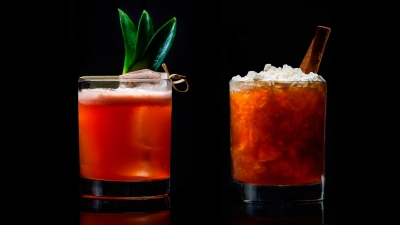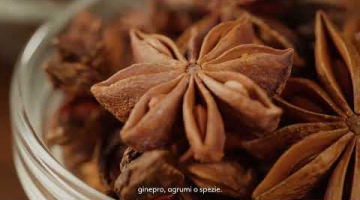Once a bitter outlier in the tiki canon, the Jungle Bird's growing popularity has given rise to a whole new catalogue of riffs on the original. Kara Newman on the appeal of the drink among bartenders and what Jungle Bird 2.0 looks like.
Whether clarified, spherified, caffeinated or chile-spiked, the Jungle Birdcocktail has taken on new plumage lately.
“Bartenders love the Jungle Bird because it’s exactly what a good cocktail is supposed to be: more than the sum of its parts,” explains Meaghan Dorman of The Raines Law Room at the William Hotel in NYC. While many bartenders are happy to simply serve the original recipe that debuted circa 1978 at the Kuala Lumpur Hilton—dark Jamaican rum, Campari, pineapple juice, lime and simple syrup—the rosy-red drink has proven to be a versatile canvas for experimentation.
“The ingredients combine into a very unique flavor, so it’s a good formula to pull out one aspect and plug in something similar,” says Dorman, “and continuing to take steps away from the original to make something new.”
Her variation, called the Getaway Car, takes a spicy-sweet turn, swapping out Campari for Ancho Reyes chile liqueur, which she then finishes with a sprinkle of ancho chile powder. Hers is one of a number of new Jungle Bird riffs that have been popping up on menus across the country of late—a sign that the once-obscure tiki drink has officially joined the cocktail mainstream.
But how did it get here? Jeff “Beachbum” Berry, author and owner of Latitude 29 in New Orleans, discovered the recipe as he dug through a stack of dusty paperbacks in a thrift store in the mid 1990s. Located within a 1980s paperback, The New American Bartender’s Guide, by John J. Poister, the Jungle Bird caught his eye. But he nearly tossed it away.
“It was a squeaker,” he recalls. “The only thing that made it interesting was that Campari was in it. A tropical drink with an amaro was unusual.” Berry made some tweaks to the recipe, in particular changing generic “dark rum” to the more specific, molasses-y Jamaican rum. That recipe went into his book, Intoxica, in 2002, and he didn’t give it another thought for years.
While it’s still hard to determine when the Jungle Bird started to appear on modern-day drink menus, Berry is certain that it became popular because bartenders have embraced bitter-edged Campari over the past few years. “It was the one tiki drink you’d find in craft cocktail bars that wanted nothing to do with tiki,” he says.
Without doubt, its watershed moment was when Giuseppe González (who now owns NYC’s Suffolk Arms) made critical adjustments to the Jungle Bird, putting it on the menu at now-closed urban tiki bar Painkiller/PKNY in 2010. The original drink contained a whopping four ounces of pineapple juice, which placed it firmly outside the interest of most craft cocktail bartenders. So he dialed it back to about an ounce and a half, and made a second, equally important change: He subbed out Berry’s Jamaican rum for richer blackstrap rum. These changes had the effect of bringing the sharp, citrus notes of Campari into relief—and the drink further into alignment with more avant-garde tastes.
Bartenders couldn’t help but take notice; the drink found its way over to influential speakeasy Milk & Honey, where Sam Ross (now of Attaboy) then worked. After trying Gonzalez’s version at Painkiller/PKNY, “I was immediately enamored and made it for everyone who sat in front of me,” Ross recalls.
From there, the Bird took flight. The New York Times chronicled the drink’s burgeoning popularity in 2014, officially putting the Jungle Bird on the map. Since then, the variations have become increasingly baroque, with bartenders adapting the drink to suit their tastes and the aesthetics of their respective bars.
For example, at NYC’s Booker and Dax, the drink wears a more modernist cloak—moonlighting as a stirred drink with a split base of blackstrap and Jamaican rums, plus Campari and clarified pineapple and lime juices. The Stirred Bird, as it’s known, is served in a streamlined coupe glass sans all tiki trappings, including garnish.
Modernist technique also plays a role in the variation at Chicago’s The Aviary. There, the Jungle Bird is served tall and layered like a Pousse-Café, with two kinds of rum (Brugal Dry and Gosling’s), more Gosling’s by way of little bubble-tea-like balls that “pop” in the mouth, Campari and tropical fruit. (For a bar called “The Aviary,” a Jungle Bird was a mandatory addition to the menu, says beverage director Micah Melton.)
Some new-age Jungle Bird iterations even eschew rum. At Cindy’s, the rooftop restaurant at the Chicago Athletic Association Hotel, the genteel Roman Holiday is offered as a brunch drink, made with Amaro Meletti, Campari, pineapple and lime, and punched up with cold-brew coffee and cinnamon. Similarly, at Chicago’s Lost Lake, the Ruby Mae’s Second Surfin’ Bird from tiki expert Paul McGee replaces rum with tequila (plus mezcal, in a supporting role) along with ruby port and passionfruit syrup. But, in an all-out bow to its tiki roots, the drink, which serves six, is appropriately presented in a scorpion bowl crowned with a flaming lime hull.
Even “Beachbum” Berry, who unearthed the drink the first time, will be adding a new version to his Latitude 29 menu in June. Called Paul of the Jungle, his Jungle Bird 2.0 is made with a split base of bourbon and rum, plus a “bird mix” of three bittering agents (Campari, Averna and red vermouth) developed by bar manager Brad Smith. The drink is named for local bartending legend, Paul Gustings, Berry explains, adding a friendly dig: “It’s nice and bitter, like Paul.”
thanks to: http://punchdrink.com/articles/second-coming-of-the-jungle-bird-cocktail...
















